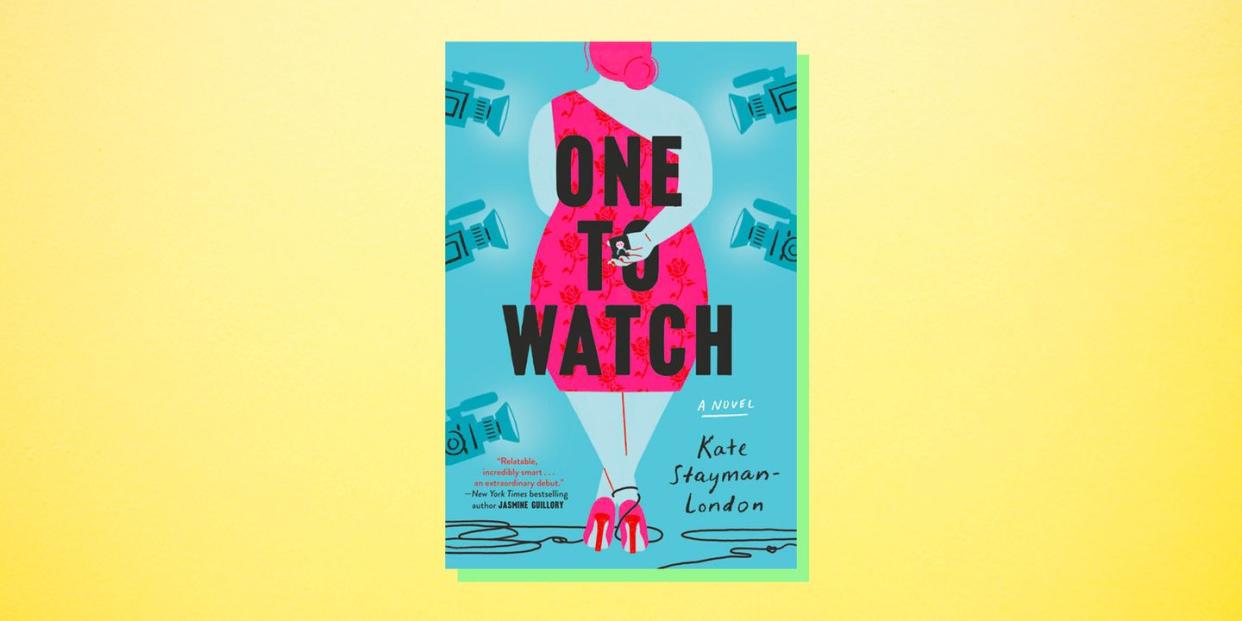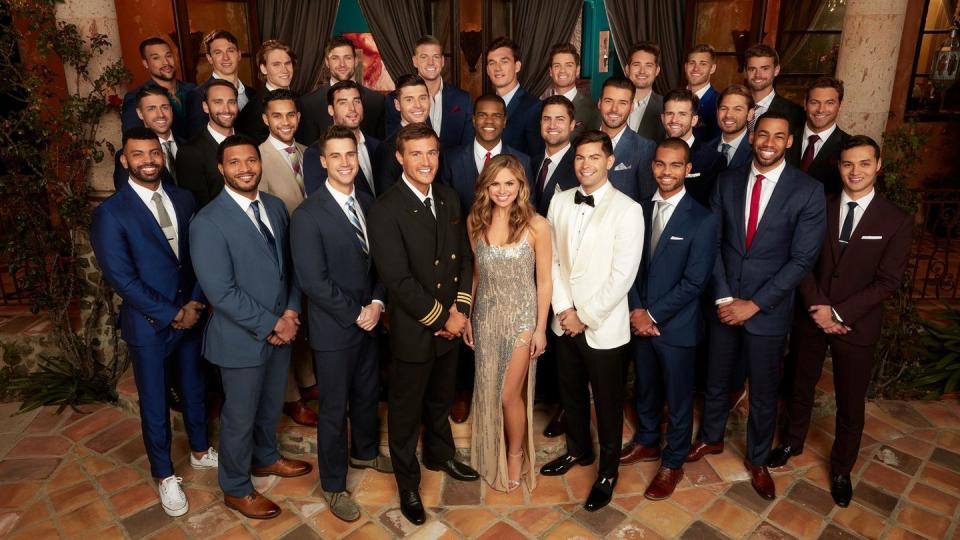The Novel "One to Watch" Envisions the "Bachelorette" With a Plus-Size Lead

While The Bachelor franchise has certainly evolved since its inception 2002, especially when it comes to racial diversity (its first Black leading man, Matt James, was cast in June), there’s been nearly no progress on the body diversity front. Season after season, another batch of mostly white and forever fit women and men are selected to embark on a journey of “true love.” The lineup of contestants represents an Instagram Discover page better than they do the actual demographic makeup of the U.S.
This is precisely why Kate Stayman-London, a first time-novelist whose debut has already ended up on the USA Today bestseller list, decided to reimagine the iconic show in her novel, One to Watch.
“What would it look like if this show that’s brought me so much escapist joy over the years actually reflected what love looks like in the real world, and not just on reality TV?” Stayman-London tells OprahMag.com, recalling the question that she asked herself one night after watching the season finale of Nick Viall’s season of The Bachelor.
Stayman-London has been a loyal fan of the franchise since its first season almost two decades ago, never missing a season or meme-worthy moment. But in late 2016, coming off her job as lead digital writer on Hillary Clinton’s campaign, she sensed a strong change in the social climate in response to the 2016 collection. Under the new presidential administration—one she, along with other Clinton staffers had not been anticipating—it became clear that elevating marginalized voices was more important than ever, including those of plus-sized women like herself.
She might not change reality—but Stayman-London figured she could imagine a better version of reality TV. And perhaps a better version of reality TV could lead to changing the beauty standards that restrict people, especially women.
“These incredibly heteronormative, hyper-feminine beauty standards are especially harmful for women who don't conform to them, who struggle to get jobs and access to fair and unbiased medical care, and to be seen for who they are and their friendships and romantic lives,” Stayman-London says.
One to Watch follows Bea Schumacher, a plus-size fashion blogger who winds up the lead on The Main Squeeze, a fictional show clearly riffing off The Bachelorette. Bea ended up on the show precisely because she’s skeptical of it: She wrote a blog post expressing her distaste for reality TV’s unrealistic quest for love.
As the first plus-size contestant in The Main Squeeze’s history, being broadcast in front of a massive national audience comes with highs and lows. While Bea's certainly the object of desire, she’s also often the target of bullies—subtle and loud. In clear instances, One to Watch depicts how society still perceives, and vocally responds to, fat bodies.

Take the moment in the novel that Bea’s identity is revealed in The Main Squeeze's premiere first episode. As they step out of the limo, her suitors’ reactions are captured on live television. To say this sequence is cringeworthy is an understatement. While a few suitors recognize beauty and size are not mutually exclusive, many others do not. Their distaste is written on their faces.
Essentially, by going on reality TV, Bea opens herself up to a magnified form of scrutiny—already harmful on an individual level. To create Bea, Stayman-London had to take her own experiences with bullies and multiply them to the scale of stardom.
"When you've experienced all kinds of negative attacks against your body, it can be really hard to trust someone and to open up and share that trust. And particularly when you’re on camera in front of an audience,” Stayman-London says.
Despite these sequences, One to Watch is a fundamentally entertaining and uplifting book. Throughout her journey, Bea comes to terms with a new part of herself, letting go of long-held insecurities. The real whirlwind romance is between Bea and herself—but of course, there’s a conventional love story in there, too.
One to Watch offers a powerful imagining of how reality TV could look, with different casting parameters. “Love on reality TV should look like this. We’re watching shows like The Bachelor for the joy of just seeing two people fall in love. What's wonderful is seeing these people actually find each other, right there in front of us on television, regardless of size, race, or gender,” Stayman-London says.
Through Bea, Stayman-London dismantles stubborn and destructive ideas about plus-size women: Namely, that they can’t be fashionable, popular, or successful. She’s complex in a way that fictional plus-size characters often aren’t.
As someone with a presence in the online plus-size fashion space myself, I found Bea’s inner dialogue to be refreshing and relatable to my own experiences. For instance, prior to joining the reality show, Bea was confident in posting a photo of herself in a bathing suit on Instagram. However, when one of the dates with her potential suitors involves getting into a bathing suit and parading around a yacht, she’s instantly apprehensive. Now, it won’t be thousands of her fellow body positivity followers seeing her, but millions of Americans—some of whom, chances are, will shame her figure.
This is a challenge I’ve faced regularly before, though not quite to that intensely public degree. There are times when I’m completely comfortable taking my shirt off and jumping into the pool with my friends and family. Other times, the thought of doing so is enough to make me shut down. Body image is never linear—every day won’t be your most confident day.
Still, within the body positive community, there’s an unspoken pressure to constantly preach self-love, even if you’re struggling with issues like self image and body dysmorphia. Bea’s inner dialogue is a reminder that body positivity and self-love is a lifelong journey.
“Often when you read about plus-size protagonists, they're just really boss tough women who never feel insecurities,” Stayman-London adds. “If you're a woman who’s opinionated on the internet [like Bea], you're gonna get a lot of feedback about the way that you look because it's a way that men exert power and ownership over powerful women by commenting on their body size in particular.”
A post shared by Kate Stayman-London (@__ksl) on Jun 7, 2020 at 12:44pm PDT
Given the premise, One to Watch also depicts how dating and body positivity intersect. Jefferson, a suitor who also happens to be plus-size, struck a particular chord with me. Often, I find myself the only man above a size XL in fashion spaces, just as Jefferson is the only plus-size man in the show.
Like Bea, Jefferson is affected by the outdated and damaging beauty ideals of society. Jefferson’s ability to address his insecurities and connect with Bea on this deeply personal level is something we rarely see, even off the page. Men are often far less likely to open up about topics like body image. From my experience, it often seems like if a man opens up about his insecurities, he’s perceived as weak.
“[One to Watch was] a chance to take the gender dynamic that we're so used to seeing on shows like The Bachelor and turn it on its head," Stayman-London says.
Since its publication on July 7, Stayman-London says she has been overwhelmed by the reaction to the book, and how significantly Bea resonated with readers.
"It was really cathartic to be at the end of the three year process of writing this book, kind looking back on some of my tougher memories, and feeling like I'd closed the chapter on some of those heartbreaks. It really felt like telling these stories and helping her exorcise her demons helped me exercise and heal some of mine,” Stayman-London says.
As the title makes clear, One to Watch is a book to watch. With her USA Today bestseller, Stayman-London has tapped what it’s like to live in a fat body in 2020, and how representation on screen can have a life-changing impact to many who have been marginalized because of solely the way they look.
Can showing diverse bodies on reality TV change the future of representation? Perhaps. But without a doubt, it would help members of the plus-size community see that regardless of size, they are worthy of love, happiness, and acceptance—no matter what the trolls may say.
For this more stories like, sign up for our newsletter.
You Might Also Like

